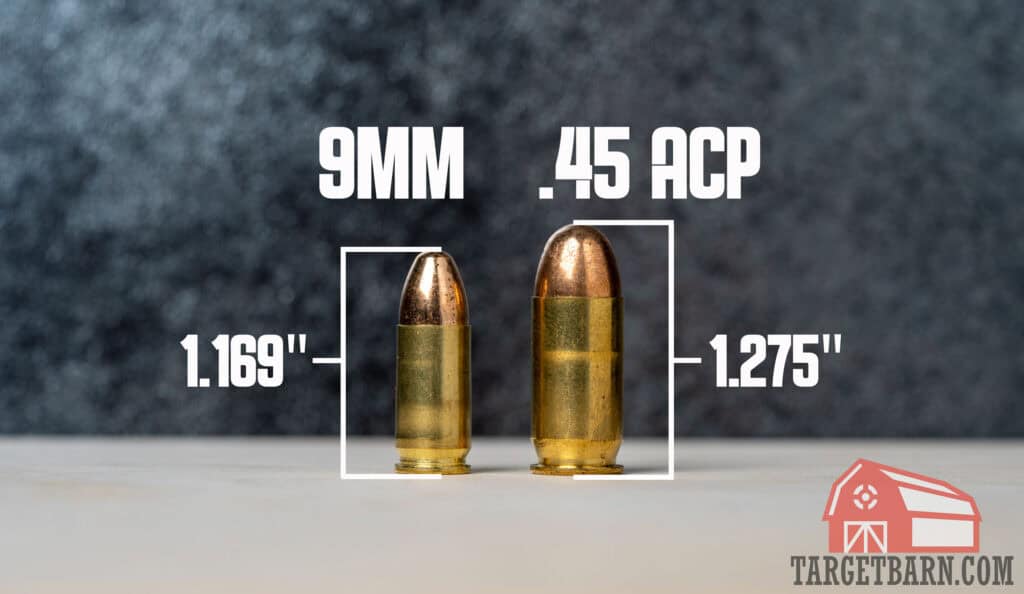When it comes to self-defense handguns, the debate between the 9mm and .45 caliber rounds is ongoing. Which one is better for your self-defense needs? To answer this question, we must dive into the concept of knockdown value (KDV) and kinetic energy. Understanding these factors will help you make an informed decision about which caliber suits your self-defense requirements best.
Understanding Kinetic Energy
Before we delve into the specifics of 9mm vs. .45 caliber, let’s understand kinetic energy. Kinetic energy is the energy that a bullet carries due to its motion. It is calculated using the formula:
KE=12×mass×velocity2KE = \frac{1}{2} \times \text{mass} \times \text{velocity}^2KE=21×mass×velocity2
Here, mass refers to the grain of the bullet, and velocity is the speed of the bullet in feet per second (FPS). The result is measured in joules, a unit of energy.
Calculating Knockdown Value
Let’s apply this formula to both 9mm and .45 caliber rounds to determine their knockdown value.
For the 9mm Round:
- Mass (Grain): 147 grains
- Velocity (FPS): 1,000 feet per second
KE9mm=12×147×(1,000)2=73,500,000 joulesKE_{9mm} = \frac{1}{2} \times 147 \times (1,000)^2 = 73,500,000 \text{ joules}KE9mm=21×147×(1,000)2=73,500,000 joules
For the .45 Caliber Round:
- Mass (Grain): 230 grains
- Velocity (FPS): 935 feet per second
KE.45=12×230×(935)2=100,535,875 joulesKE_{.45} = \frac{1}{2} \times 230 \times (935)^2 = 100,535,875 \text{ joules}KE.45=21×230×(935)2=100,535,875 joules
From these calculations, we can see that the .45 caliber round has a higher knockdown value than the 9mm round. Specifically, the .45 caliber generates over 100 million joules, while the 9mm generates 73.5 million joules.
Practical Considerations
While kinetic energy is crucial, other factors should influence your choice of caliber for self-defense:
- Handling and Recoil: The .45 caliber typically has more recoil than the 9mm, which can affect your accuracy and control, especially in high-stress situations.
- Capacity: 9mm handguns generally have a higher magazine capacity compared to .45 caliber handguns. More rounds can be a significant advantage in a self-defense scenario.
- Size and Weight: 9mm handguns are often lighter and more compact, making them easier to carry and conceal.
- Cost and Availability: 9mm ammunition is usually more affordable and widely available, allowing for more frequent practice.
Conclusion
In terms of knockdown value and kinetic energy, the .45 caliber has a clear advantage over the 9mm. However, the best caliber for you depends on various factors, including handling, capacity, and personal preference. Use the kinetic energy formula to compare different calibers and find the one that meets your needs.
Experiment with different ammunition and practice regularly to ensure you are comfortable and proficient with your chosen self-defense handgun. Remember, the most effective weapon is the one you can handle confidently and accurately.
Let us know your thoughts and findings on this age-old debate.
Stay Lethal My Friends,
Joe Malone


I would like to see a list of 9mm handguns that can be fired one handed and be in the micro 9 size, I have a Kimber micro nine that will jam often when fired with one hand ,i like everything else about the Kimber but it has to be replaced and i don't care to make the same mistake again thanks,,,,,,,,,,Jon
Jon, I just emailed you a diagram of handguns and sizes… The Kimber you’re talking about would be in the extra small category (I believe), but I’d reccomend something at least in the small, maybe medium category for most men.